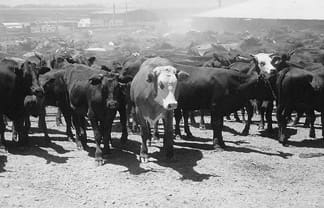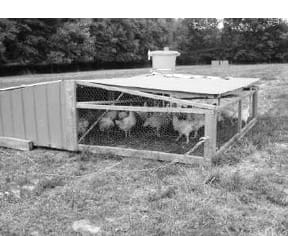by CJ Puotinen The foundation of nearly every home-prepared diet for dogs is animal-source protein, such as beef, lamb, chicken, turkey, dairy products, or eggs. These foods are so abundant in our supermarkets that we take them for granted and assume they are nutritious. After all, our scientists, public health officials, and medical experts make no distinction between food produced by animals raised outdoors on open pasture and that of animals raised in confinement on factory farms.

But you are what you eat, as the saying goes, and the difference between the meat of factory-raised animals and animals that dine on open pasture is dramatic. Many holistic veterinary health practitioners routinely recommend that their patients eat animal origin products only if they are organic and pasture-fed or free-range. Problems with factory-farmed Almost 90 percent of America’s farm animals live on factory farms, where, instead of green grass, they eat packaged foods that may contain ingredients they were never designed to consume, such as corn and soybeans – or, for roughage in the mixed feed, ground-up phone books, plastic pot scrubbers, or stale-dated chewing gum, complete with wrappers. Overcrowding, a lack of sunlight and fresh air, the routine application of drugs and pesticides, inactivity, and stress weaken their immune systems, make them susceptible to infections and chronic illnesses, soften their bones, and reduce the quality of their meat and eggs. Feedlot cattle are routinely treated with dewormers like Dectomax, Ivermectin, and other systemic pesticides, which are supposed to leave the animals after six months but residues of which can remain in their fat for much longer. Additional toxins migrate to fat cells, while others, such as heavy metals, collect in the bones. Of all the cows that are culled and taken to slaughter, only five percent (1 in 20) have livers that can be salvaged, for the high protein levels of soy-based feed damage the bovine liver. Virtually all animals raised in confinement are given antibiotics to keep them alive and encourage weight gain, hormones to regulate their growth and reproductive cycles, seven-way combination vaccines, and steroids to stimulate growth. Drug residues concern health experts because they encourage the development of drug-resistant bacteria and can adversely affect human health. Athletes who consumed factory-farmed chicken have failed urine tests for steroid drugs, and medical journals have documented the adverse effects of hormone-treated chicken on children. “Confinement operations could not make a profit if their animals were subject to strict health standards,” says Sally Fallon, director of the Weston A. Price Foundation, an organization that advocates a return to nontoxic farming methods and the consumption of whole foods. “Cows with mastitis are milked anyway. Poultry inspectors used to condemn all birds with air sacculitus, a disease that causes yellow fluids and mucus to break up into the lungs. Today, many of these birds are approved.” Factory-farmed hens suffer from “caged layer fatigue,” a form of osteoporosis caused by a lack of fresh air and sunshine combined with the mineral-depleting demands of constant egg laying. Despite being fed calcium supplements, bone fractures and paralysis are common. Forced molting, in which hens are deprived of food and water to shock them into starting a new egg-laying cycle, is banned in Great Britain but common in North America. Broiler hens are fed growth hormones, antibiotics, and animal byproducts, including condemned and diseased parts. Animal health advocate Michael W. Fox, DVM, warns that intensive confinement systems produce food-borne diseases that ultimately affect humans and benefit only the pharmaceutical and medical industries. Chickens and turkeys can be sold as “free-range” if they have USDA-certified access to the outdoors for five minutes per day. But the term “range,” a synonym for pasture, has lost its meaning, as there are no criteria for the outdoor area’s size, environmental quality, or space allowed per bird. All too often, factory-farmed free-range birds live in crowded conditions on gravel or concrete with no access to grass of any kind and little, if any, access to the outdoors. These birds are debeaked (a procedure that impairs their ability to preen and eat normally) and live in unnatural social isolation rather than in family groups. Cancer is so common that commercially raised animals are accepted for human consumption after their tumors are removed. Fewer inspectors and faster assembly lines make even the most cursory inspections difficult or impossible. Many supermarket chickens are infected with salmonella, and beef is frequently recalled because of E. coli contamination. Federal officials respond to these problems by allowing drug manufacturers to supervise the testing of their own animal drugs in order to complete the approval process as quickly as possible, raising questions about safety and effectiveness. To treat salmonella, E. coli, and other pathogens in meat products, they recommend formaldehyde rinses, chlorine rinses, and irradiation. These treatments apply to meat and poultry sold for human consumption, the “best” that modern agriculture has to offer. Fortunately, a revolution is brewing, and it’s one that may remedy the ills of modern food production. Farmers and ranchers are rediscovering the benefits of pasture feeding, and because the animals they grow are significantly healthier than animals raised in confinement, their meat, bones, organs, and eggs are significantly better for people and dogs. Healthful farms Milton Rodewald raises chickens, turkeys, ducks, geese, sheep, pigs, and cattle in upstate New York at Thistle Downes, a fast-growing farm that has been free since 1997 of chemical fertilizers, pesticides, herbicides, or other agricultural chemicals. As a result of efficient management, the land’s vegetation is rich in vitamins, minerals, and other nutrients, and the farm produces only a fraction of the runoff and erosion that plague conventional farms.

“Some of our customers are people with severe chemical sensitivities,” says Rodewald. “If they eat commercially raised meat or poultry, they get physically ill. Now I’m starting to hear from people whose dogs have the same problem. We’re happy to save extra bones, organs, and chicken feet for them, and occasionally someone buys whole lambs or chickens for their dogs.” Like many producers of pasture-fed animals, Rodewald has mixed feelings about applying for organic certification under new USDA regulations. “That’s partly because of the expense and paperwork,” he says, “but it’s mostly because our methods are so far beyond what the government requires for organic certification that we consider organic and free-range to be misleading labels. I call our methods ‘beyond organic.’ ” Open-door policy Thistle Downes is open to customers, who can pick up orders in person or at farmers’ markets. “I encourage people to visit,” says Rodewald. “Every step of our operation, from the way we improve the soil to the way we constantly move the animals to fresh pasture, maintain their health with natural methods, and process them humanely, is out in the open for all to see.” Unlike ruminants, chickens require grain in addition to pasture for optimum health. Rodewald grinds fresh grain every day, having found that his chickens’ improved health makes the effort cost-effective. “If you raise birds in confinement,” he explains, “with limited access to a crowded outdoor pen, and feed them rancid grain and returned, stale baked goods from a certified organic bakery, no one will question your organic free-range label. But their health and the quality of their meat and eggs will be completely different from that of chickens raised on pasture and freshly ground grain. To the consumer the health benefits are a plus, but it’s the flavor that makes our meat, poultry, and eggs so popular.” If people can taste the difference, imagine pasture-fed meat from our dogs’ perspective. “Grocery store meat gets a brief sniff and mild interest,” says Sarah Wilson-Kilcommons, author of Good Owners, Great Dogs and other books. “But when local hunters drop meat off, my normally well-behaved group loses their collective mind. They try to dive into the bag and they gulp down every tidbit with primal efficiency and enthusiasm. There is definitely something different about ‘real’ meat.” Tennessee rancher Jenny Drake, whose Peaceful Pastures farm ships beef, pork, lamb, goat, chicken, duck, and turkey to customers throughout the country, gives credit for the health of her dogs to their simple diet of raw milk and raw meat. In addition, Drake feeds them organs, which have little commercial value but which are rich in beneficial bacteria, enzymes, vitamins, minerals, and other nutrients. Drake, like Rodewald, raises chickens in portable grazing pens in open, grassy fields. The pens provide fresh air, room for exercise, and protection from predators in addition to the benefits of fresh pasture. “All of our animals have comfortable, relaxed lives, maintaining their natural social structure,” says Drake. “Their immune systems are strong, and they don’t suffer from the diseases, parasites, lameness, and stress that affect factory-farmed animals.” Like many small farms, Peaceful Pastures processes its own poultry and transports other animals to a nearby processing plant. “We time the loading and departure to make this as stress-free as possible,” says Drake. “Our cattle are never herded into large trucks and shipped long distances, nor do we withhold food and water, which is another common practice.” The down side of pasture-fed meat, poultry, and eggs is that they are more expensive than their factory-farmed counterparts and, when applicable, shipping costs add to the expense. Suzanne Clothier, author of Bones Would Rain from the Sky and other books about dogs, raises Scottish Highland cattle, chickens, turkey, eggs, vegetables, fruit, and hay at her Hawks Hunt Farm in upstate New York. Like many pastured farms, Hawks Hunt participates in a Community Supported Agriculture (CSA) Subscription Farming program through which customers place orders. “I’d love to feed our dogs nothing but pasture-fed meat,” says Clothier, “but that would require far more animals than we now raise, complete with the expense and effort that would involve, plus a staggering amount of freezer space. “I wish more people understood how meat animals are raised, the economics and scheduling of such, their life cycles, and the limitations small farms have. When customers call to ask for 50 pounds of liver or 100 pounds of chicken necks, they have no idea how many dead cows or chickens that represents. Most people know very little about their own food, never mind their dogs’ food.” Managing the cost To make food for dogs more affordable, some farms have pet specials. In addition to offering Peaceful Pastures “pet coolers,” Jenny Drake notifies customers when she plans to cull an older cow, goat, steer, or sheep, selling the custom-butchered animal at a deep discount. At Sojourner Sheep in Massachusetts, Diane Roeder sells lamb and mutton for pet consumption. “That lowers the price,” she explains, “because the yield is greater.” In Missouri, veterinarian Patricia Whisnant sells meaty bones, organs, and ground beef for dogs. Her American Grassfed Beef Web site provides extensive information on the BARF (Biologically Appropriate Raw Foods) diet and offers free shipping on pet food specials. Some farms, such as Simply Grazin’ in New Jersey, schedule free or inexpensive truck deliveries. Staying in touch with farmers and sharing orders with friends has helped many caretakers improve their dogs’ diets.
Real milk The same comparisons that apply to factory-farmed and pasture-fed meat and eggs apply to milk. Raw colostrum from pasture-fed cows and goats, recommended by holistic veterinarians as a potent immune system tonic, and raw cow or goat whey, a cheesemaking byproduct that is easy to digest and rich in beneficial bacteria, are popular extras for those who can find them. So is raw butter, a traditional food that improves health by providing fat-soluble vitamins; short- and medium-chain fatty acids that stimulate the immune system and protect against disease; glycospingolipids, which prevent intestinal distress; and conjugated linoleic acid (CLA), which helps protect against cancer and heart disease. Milk from pasture-fed cows contains five times more CLA and twice the omega-3 fatty acids and beta-carotene of milk from cows fed a commercial dairy diet. To find a pasture-fed dairy or goat farm, check the resources listed here as well as farmers’ markets and health food stores. Peaceful Pastures ships a variety of pasture-fed dairy products for pets. Fish facts The problems stemming from factory-farmed animals are not unique to furry and feathered species. Wild-caught fish is the finned equivalent of pasture-fed meat, but most of America’s salmon, trout, halibut, mussels, oysters, and other food fish are farmed in crowded open-net cages set up in the ocean or fresh water. Fish farms often use large quantities of antibiotics and pesticides to control disease, and parasites proliferate. Researchers blame farmed fish for human exposure to antibiotic-resistant bacteria, dioxin, and PCBs, as well as possible retinal damage from the ingestion of color additives. “Farmed fish is nutritionally worthless,” says Sally Fallon, who contrasts its low vitamin and mineral content to that of wild-caught fish. “In addition, fish farms create an ecological nightmare, with escaping fish spreading disease or replacing wild species and raw sewage waste causing serious pollution.” For your fish-loving dog and for your own improved health, look for wild-caught fish and avoid farmed fish. Check with vendors about the source. Unless wild-caught Pacific salmon or farmed fish of any kind has been tested for parasites, it is probably safer cooked than raw. Also With This Article Click here to view “Pasture-Fed Animals Provide Healthier Meat and Dairy Products For Your Dog”.” Click here to view “Raw Food Dog Recipes”






I buy raw milk from the Amish who raise Guernsey cows. My dog loves the milk. He is a 14 yr old Springer Spaniel. He has wonderful teeth, strength in his legs, and energy to run. We also feed him the organs, tongue, from our beef we get that is raised on organic grass. He feels better taking him off dry food. People do not know what and where the food in the store is coming from or how treated and the animals raised. We need a clearing out at the FDA. Too many there make decisions that profit big business and pharma.